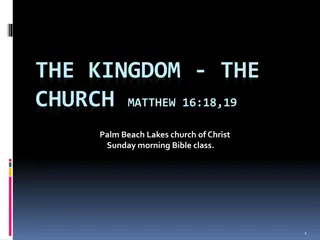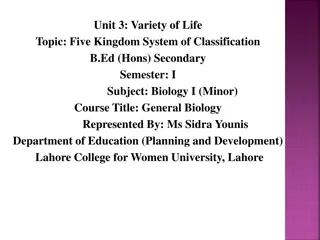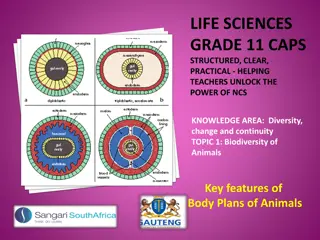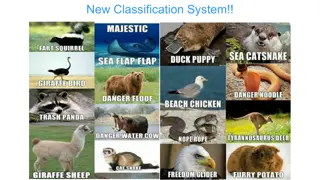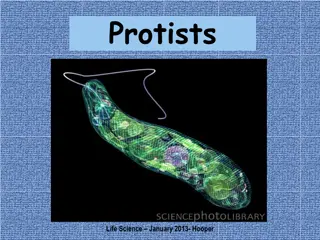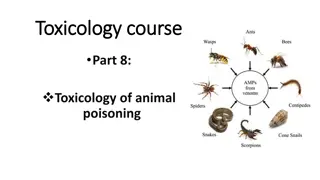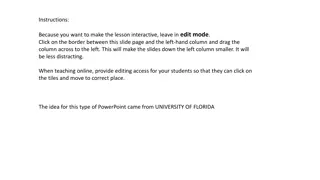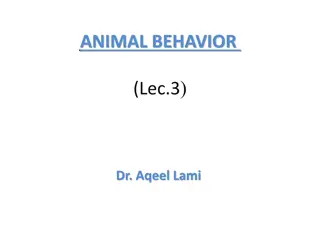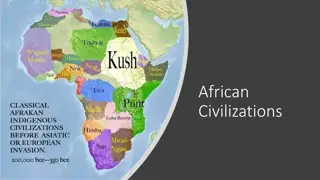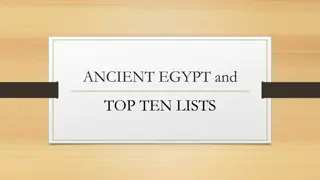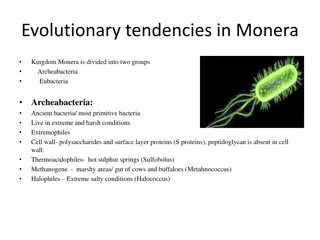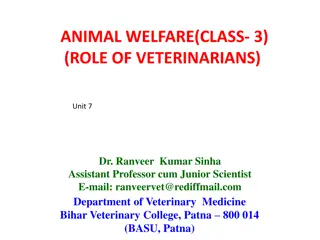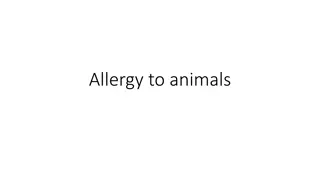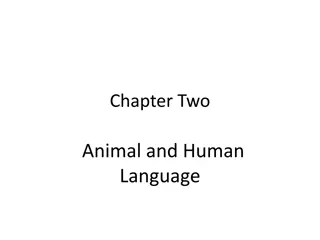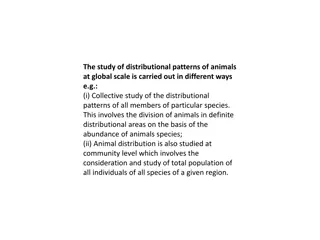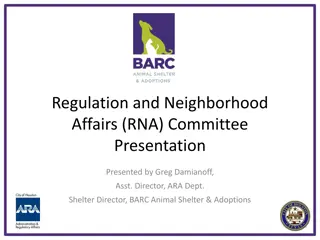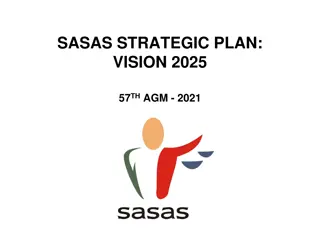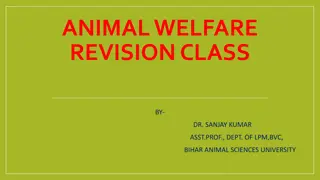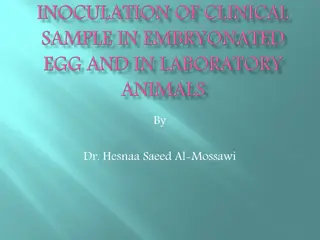Introduction to Animal Kingdom Classification
This content provides an overview of the classification and organization of the animal kingdom. It covers topics such as levels of organization, symmetry types, diploblastic and triploblastic organization, coelom types, and segmentation in animals. The information is structured with images and descriptions for better understanding.
Download Presentation

Please find below an Image/Link to download the presentation.
The content on the website is provided AS IS for your information and personal use only. It may not be sold, licensed, or shared on other websites without obtaining consent from the author. Download presentation by click this link. If you encounter any issues during the download, it is possible that the publisher has removed the file from their server.
E N D
Presentation Transcript
ANIMALKINGDOM RAJESWARI PGTBIOLOGY
LEVELS OFORGANISATION Cellular level of organization Sponge Tissue level Organlevel Organ system level Digestive system in Platyhelminthes has only a single opening to the outside of the body that serves as both mouth and anus, and is hence called incomplete. A complete digestive system has two openings,mouthandanus. Circulatory system maybe of twotypes: Open type in which the blood is pumped out of the heart and the cells andtissues are directly bathedinitand Closed type in which the blood is circulated through a series of vessels ofvarying diameters (arteries, veins andcapillaries).
SYMMETRY Asymmetrical - any plane that through the centre does not divide them into equal halves. Ex.Sponges passes Radialsymmetry Radial symmetry -When any plane passing through the central axis of divides the organism into two identical halvesEx. Coelenterates, ctenophores and echinoderms havethis kindof bodyplan. the body Bilateralsymmetry Bilateral symmetry -Animalslike annelids, arthropods, etc., where the body can be divided into identical left and right halves inonly one plane,exhibit
Diploblastic and TriploblasticOrganisation Diploblastic animals - Animals in which the cells are arranged in two embryonic layers, an external ectoderm and an internal endoderm, e.g., coelenterates. Anundifferentiatedlayer,mesoglea,ispresentinbetweentheectoderm and the endoderm. Triploblastic animals - Those animals in which the developing embryo has a third germinal layer, mesoderm, in between the ectoderm and endoderm.e.g. (platyhelminthestochordates (a) Diploblastic (b)Triploblastic
COELOM The body cavity, which is lined by mesoderm is calledcoelom. Animals possessing coelom are called coelomates, e.g., annelids, molluscs, arthropods, echinoderms, hemichordates andchordates . In some animals, the body cavity is not lined by mesoderm, instead, the mesoderm is present as scattered pouches in between the ectoderm and endoderm. Such a body cavity is called pseudocoelom and the animals possessing them are called pseudocoelomates,e.g.,aschelminthes . The animals in which the body cavity is absent are called acoelomates, e.g.,platyhelminthes .
sectional view of : (a) Coelomate (b) Pseudocoelomate (c)Acoelomate
SEGMENTATION In some animals, the body is externally and internally divided into segments with a serial repetition of at least some organs. For example, in earthworm, the body shows this pattern called metameric segmentation and the phenomenon is known asmetamerism. NOTOCHORD Notochordisamesodermallyderivedrod-likestructureformed on the dorsal side during embryonic development in some animals. Animals with notochord are called chordates and those animals which do not form this structure are called non-chordates, e.g., poriferato echinoderms
PHYLUM PORIFERA commonly known as sponges asymmetrical animals Sponges have a water transport or canal system Digestion is intracellular. Sexes are not separate (hermaphrodite) Examples: Sycon (Scypha), Spongilla (Fresh water sponge) and Euspongia (Bath sponge). Examples of Porifera : (a) Sycon (b) Euspongia (c)Spongilla
PHYLUM COELENTERATA(CNIDARIA) They are aquatic, mostly marine, radially sessile symmetrical animals The name cnidaria is derived from the cnidoblasts or cnidocytes contain the stinging nematocytes) present on the tentacles and the body. Cnidoblasts are used for anchorage, defense and for the capture ofprey. tissue level of organisation and are diploblastic Digestion is extracellular intracellular Cnidarians exhibit two basic body forms called polyp and medusa or free-swimming, (which capsules or Examples of Coelenterata indicating outline of theirbody form : (a) Aurelia (Medusa) (b) Adamsia(Polyp) and Diagrammatic viewof Cnidoblast
PHYLUM CTENOPHORA Ctenophores, commonly known as sea walnuts or comb jellies are exclusively marine, symmetrical, organisms with tissue level of organisation. The rows of ciliated which help inlocomotion. Bioluminescence(the property of a living organism to emit light) is well-marked in ctenophores. Sexes are notseparate. radially diploblastic body bears eight comb external plates, Example of Ctenophora (Pleurobrachia
PHYLUM PLATYHELMINTHES They have dorso-ventrally flattened body,hence are called flatworms. These found in animals including human beings. are mostly endoparasites Flatworms symmetrical, acoelomate animals with organ level oforganisation. are triploblastic bilaterally and Hooks and suckers are present in the parasitic forms. internal and development is through manylarval stages Fertilisation is Examples of Platyhelminthes : (a) Tape worm(b) Liverfluke
PHYLUM ASCHELMINTHES The body of the aschelminthes circular in cross-section, hence, the nameroundworms. Roundwormshaveorgan-system level of body bilaterally symmetrical, triploblastic and pseudocoelomate animals. . Sexes are separate (dioecious). Often females are longer thanmales. Fertilisation development may be direct (the young ones resemble the adult) or indirect. is organisation. They are is internal and Aschelminthes Roundworm
Phylum Annelida They may be aquatic (marine andfresh water) or terrestrial; free-living, and sometimesparasitic. Exhibit organ-system level of body organisation and bilateralsymmetry. Triploblastic, metamerically segmentedand coelomateanimals. Their body surface is distinctly marked out into segments or metameres and, hence,the phylum nameAnnelida A closed circulatory system ispresent. Nephridia (sing. nephridium) helpin osmoregulation andexcretion Nereis, an aquatic form, is dioecious, but earthworms and leeches aremonoecious Examples of Annelida :(a) Nereis (b)Hirudinaria
PHYLUM ARTHROPODA This is the largest phylum of Animalia which includes insects. Over two-thirds of all named species on earth arearthropods organ-system level of organisation. They are bilaterally symmetrical, triploblastic, segmented andcoelomateanimals covered by chitinousexoskeleton They have jointed appendages (arthros- joint,poda-appendages). Sensory organs like antennae, eyes (compound and simple), statocysts or balance organs arepresent. Excretion takes place throughmalpighian tubules. They are mostly dioecious Fertilisation is usually internal. They are mostlyoviparous. Development may be direct orindirect. Examples of Arthropoda : (a) Locust (b)Butterfly (c) Scorpion (d)Prawn
PHYLUM MOLLUSCA This is the second largest animal phylum Molluscs are terrestrial or aquatic (marine or fresh water) having an organ-system level oforganisation. They are bilaterally symmetrical, triploblastic and coelomate animals. Body is covered by a calcareous shell and is unsegmented with a distinct head, muscular foot and visceral hump. A soft and spongy layer of skin forms a mantle over the visceral hump. They are usually dioeciousand oviparous with indirect development Examples of Mollusca : (a)Pila (b)Octopus
PHYLUM ECHINODERMATA These animals have an endoskeleton of calcareous ossicles and, hence, the name Echinodermata (Spiny bodied, The adult echinoderms are radially symmetrical but larvae are bilaterally symmetrical. They are triploblastic and coelomate animals. Digestive system is complete. The most distinctive feature of echinoderms is the presence of water vascular system which helps in locomotion, capture and transport of food and respiration An excretory system is absent. Sexes are separate. Reproduction issexual. Fertilisation is usually external. Development is indirect with free-swimminglarva Examples of Echinodermata : (a)Asterias (b)Ophiura
PHYLUM HEMICHORDATA Hemichordata was earlier considered as a sub-phylum under phylum Chordata. But now it is placed as a separate phylum under non-chordata The body is cylindrical and is composed of an anterior proboscis, a collar and a long trunk. Circulatory system is of opentype. Respiration takes place through gills. Excretory organ is proboscis gland. Sexes are separate. Fertilisation is external. Development is indirect. Balanoglossus
PHYLUM CHORDATA Animals belonging to phylum Chordata are fundamentally characterised by the presence of a notochord, a dorsal hollow nerve cord and paired pharyngeal gill slits . These are bilaterally symmetrical, triploblastic, coelomate withorgan-system level oforganisation. They possess a post anal tail and a closed circulatory system. Chordatacharacteristics
Comparison of Chordates andNon-chordates Non-chordates Notochordabsent Central nervous system is ventral,solid anddouble. Gill slits are absent. Heart is dorsal (if present). Post-anal tail isabsent. Chordates Notochordpresent Central system is dorsal, hollow andsingle Pharynx perforated by gillslits. Heartis ventral. A post-anal part (tail) ispresent. nervous
Phylum Chordata is divided into three subphyla: Urochordata orTunicata, Cephalochordata andVertebrata. Subphyla Urochordata andCephalochordataare often referred to as protochordates and are exclusively marine. In Urochordata, notochord is present only in larval tail, while in Cephalochordata, it extends from head to tail region and is persistent throughout their life.
Subphylum Vertebrata The members of subphylum Vertebrata possess duringtheembryonicperiod. The notochord is replaced by a cartilaginous or bony vertebral columninthe adult. Thus all vertebrates chordates but all chordates are notvertebrates. notochord are
CLASS CYCLOSTOMATA All living members of the class Cyclostomata are ectoparasiteson somefishes. They have an elongated body bearing 6-15pairs of gill slits for respiration. Cyclostomes have a sucking and circular mouth withoutjaws Their body is devoid of scales and pairedfins. Cranium and vertebral column arecartilaginous. Circulation is of closedtype. A jawless vertebrate Petromyzon
CLASS CHONDRICHTHYES Theyaremarineanimalswithstreamlinedbodyandhavecartilaginousendoskeleton. Mouth is located ventrally. Notochord is persistent throughout life. Gill slits are separate and without operculum (gill cover). The skin is tough, containing minute placoid scales. Teeth are modified placoid scales which are backwardlydirected. Their jaws are very powerful. Due to the absence of air bladder, they have to swim constantly to avoidsinking. Heart is two-chambered (one auricle and one ventricle). Some of them have electric organs (e.g., Torpedo) and some possess poison sting (e.g., Trygon). They are cold- blooded(poikilothermous)animals Sexesare separate. Theyhaveinternalfertilisationandmanyofthemareviviparous Example of Cartilaginous fishes : (a) Scoliodon (b)Pristis
CLASS OSTEICHTHYES It includes both marine and freshwater fishes with bonyendoskeleton. Their body isstreamlined. Mouth is mostly terminal. They have four pairs of gills which are covered by an operculum on eachside. Skin is covered with cycloid/ctenoidscales. Air bladder is present whichregulates buoyancy. Heart is two-chambered (one auricleand oneventricle). They are cold-bloodedanimals. Sexes areseparate. Fertilisation is usuallyexternal. They are mostly oviparousand development isdirect. Examples of Bony fishes : (a) Hippocampus (b)Catla
CLASS AMPHIBIA As the name indicates (Gr., Amphi : dual, bios, life), amphibians can live in aquatic as well as terrestrial habitats Most of them have two pairs oflimbs. Body is divisible into head andtrunk. Tail may be present insome. The amphibian skin is moist (withoutscales). The eyes haveeyelids. A tympanum represents the ear. Alimentary canal, urinary and reproductive tracts open into a common chamber called cloaca which opens to theexterior. Respiration is by gills, lungs and through skin. The heart is three- chambered (two auricles and oneventricle). These are cold-bloodedanimals. Sexes are separate. Fertilisation isexternal. They are oviparous and development isindirect. Examples of Amphibia : (a) Salamandra(b) Rana
CLASS REPTILIA The class name refers to their creeping or crawling mode of locomotion (Latin, repere or reptum, to creep or crawl).They are mostly terrestrial animals and their body is covered by dry and cornified skin, epidermal scales or scutes. They do not have external ear openings. Tympanum represents ear. Limbs, when present, are twopairs. Heart is usually three-chambered, but four-chambered in crocodiles. Reptiles are poikilotherms. Snakes and lizards shed their scales as skincast. Sexes are separate. Fertilisation isinternal. They are oviparous and development is direct Reptiles : (a) Chameleon (b) Crocodilus (c) Chelone (d) Naja
CLASS MAMMALIA They are found in a variety of habitats polar ice caps, deserts, mountains, forests, grasslands and dark caves. Someof themhave adapted to fly or live inwater. The most unique mammalian characteristic is the presence of milk producing glands (mammary glands) by which the young ones arenourished. They have two pairs of limbs, adapted for walking, running, climbing, burrowing, swimming orflying The skin of mammals is unique in possessinghair. External ears or pinnae arepresent. Different types of teeth are present in thejaw. Heart is four- chambered. They are homoiothermous. Respiration is by lungs.Sexes are separate and fertilisation is internal. They are viviparous with few exceptions and development is direct. Some mammals : (a) Ornithorhynchus (b) Macropus (c) Pteropus(d) Balaenoptera
CLASS AVES The characteristic features of Aves (birds) are the presence of feathers and most of them can fly except flightless birds (e.g., Ostrich). They possess beak The forelimbs are modified into wings. The hind limbs generally have scales and are modified for walking, swimming or clasping the tree branches. Skin is dry without glands except the oil gland at the base of the tail. Endoskeleton is fully ossified (bony) and the long bones are hollow with air cavities (pneumatic). Heart is completely four-chambered. They are warm-blooded (homoiothermous) animals, i.e., they are able to maintain a constant body temperature. Respiration is by lungs. Air sacs connected to lungs supplement respiration. Sexes are separate. Fertilisation is internal. They are oviparous and development is direct. Some birds : (a) Neophron (b) Struthio (c) Psittacula (d)Pavo


